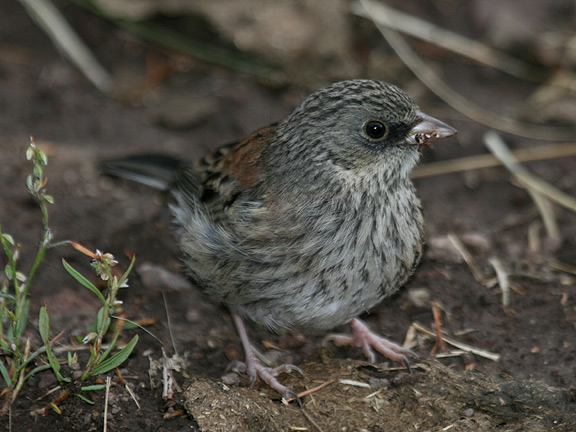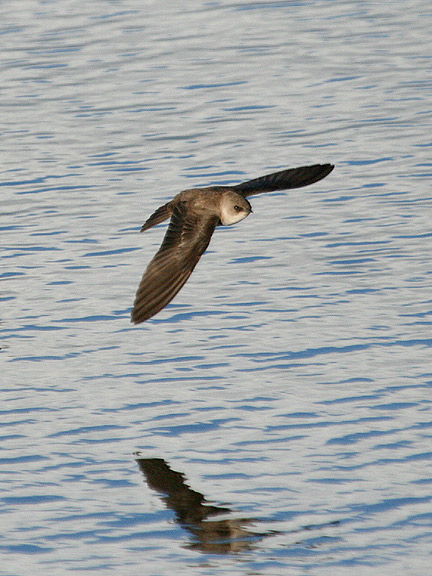Guest post from Tim Avery of the Utah Birders blog and TimAveryBirding.com
So over time I have seen numerous posts talking about bird names and some of the historic names that were a better fit, or some of the current names that don't make sense, or names that just plain suck. I often wonder why specific nomenclature was used in the first place, or changes later on aside from a species split or lump. Even then names like
Dark-eyed Junco for instance seem like an odd choice for a species that could be defined by numerous other characteristics, aside from that "dark eye". What about the
Varied Junco or the
Chattering Junco--I would even be partial to a new grouping, how about the
Chattering or
Varied Wanderer? Perhaps speaking to complex mixed breeding of the subspecies we call it the
Promiscuous Junco? That might be my favorite for this species.
 |
| Dark-eyed Junco or Promiscuous Junco?
|
How about
Rose-breasted and
Black-headed Grosbeak--those are great descriptive names for the two birds, but in terms of interesting they seem rather plain.
Gray Jay is one that really stings me--honestly something like
Alpine Jay, or
Tundra Jay is so much more fitting. But hey, the "color" gray is descriptive enough right? And it matches up to the
Green, Brown, and
Blue Jay--never mind the
Scrub or
Steller's Jay though, they were after all already blue.
 |
| Gray Jay or Alpine Jay?
|
Birds named after cardinal directions also leave me feeling uneasy. The
Northern Flicker for instance is found far and wide east to west--not to mention across the entire south. What about the
Northern Rough-winged Swallow--are we talking north of the Equator? Because the
Southern Rough-winged Swallow and it's northern cousin meet in up Central America. Lest we forget the
Eastern Towhee and the
Western Grebe and the split across this great continent. Don't get me wrong I understand why some of these birds have the generalized descriptors used for their names--but it just seems like far too many have been done a disservice because of it.
 |
| Northern Rough-winged Swallow
|
Of course there is one bird above all others that bothers me--the
Western Tanager. It's my favorite bird with a breathtaking pattern and color set. I can think of a couple name more apt--how about the
Aspen Tanager (yes this species spends a great deal of time in Aspen as well as Conifers), or
Tremulous Tanager (another take to Aspen, or
Populus tremuloides its the scientific name).
 |
| Western Tanager or Tremulous Tanager?
|
I mean saying I saw 500
Tremulous Tanagers in a day sounds way more epic than saying I saw 500 Western Tanagers in a day. Just the name adds a bit of mystique and interest. I also wouldn't feign at names like
Flammulated Tanager,
Fire-faced Tanager, or the simple yet all encompassing
Incredible Tanager. How many times have you heard a birder or non-birder alike say, "
Wow that's Incredible!" upon seeing a Western Tanager?
So now that I've told you a couple bird names I would change, if you could change 1, 2, or a few bird names, what ones would you choose, and why? Comment below anonymously or using just your name, or a Google account, etc. I'm interested to see what others have to say!






Good topic for discussion Tim. I'm in favor of completely overhauling all bird names, both common and scientific in the year 2020. Once we get some DNA relationships figured out we can overcome all the naming messes we currently have. I'm in favor of descriptor names rather than honorary names. Directional names do seem confusing and almost useless.
ReplyDeleteWestern Tanager is one of my favorite birds...I do kinda like the name Fire-faced Tanager though ;-)
ReplyDeletePrecisas aves,las fotos estupendas.Saludos
ReplyDeleteGreat post, I love the Western Tanager. It is a beautiful bird.
ReplyDeleteGreat shots Tim, really enjoyed reading this post.
ReplyDeleteOh bird names...I guess I should say first and foremost I'm just glad I don't have to learn the latin names, but yeah there are so many odd, even erroneous names out there...
Directional names are often uselesss, as Robert said. Northern Mockingbirds that don't go north, Eastern Kingbirds that turn up in Oregon...There are also those descriptive names that seem so out-of-placed, like Ring-necked Duck and Red-bellied Woodpecker. Ok, yes, these species were named from the dissection table and there is truth to their names, but it's hardly the most obvious or noteworthy feature. Don't most Mallards have more prominent neck-rings? How really looks at the marvelous Broad-billed Hummingbird and thinks, "Wow, check out the width of that bill!!! Oh yeah, the bird is pretty colorful too."
It sounds like Robert has a long-term plan in mind. It;ll be interesting to see if things work out more or less to that effect. It does seem tricky to use only descriptor names, especially with some of the Gull species and empid flycatchers, but all in all there's still lots of room to improve.
Meanwhile, we've progressed back to the 'Common Gallinule'
This comment has been removed by the author.
ReplyDeleteCongrat to post, I enjoyed! It's interesting that why they has more names than necessary? Stupidity
ReplyDeleteTim,
ReplyDeleteThe short answer is that the one who describes and organism (including birds) gets to pick the name. The International Society for Zoological Nomenclature has published standards which have a few guidelines. For example the order of precedence, is that the oldest published name is the one to be recognized. This is particularly important in lumps and splits. For example when Blue Grouse was split a few years ago the names used were Sooty and Dusky Grouse. These were not just random names but were the names first used by Meriwether Lewis and William Clark in 1806. So the AOU went with their original names. Lewis and Clark also first described the Western Tanager. Since the first specimens were collected in Idaho far west of where any other tanager had ever been found it was called the Western Tanager. So when the American Ornithological Union published the first checklist in the 1930s this is how they picked names. All changes since then have been submitted to the checklist committee for a decision.
In the case of the flicker there are 9 species of flickers current recognized in the Americas. Of these only two are found in North America one the Gilded Flicker is primarily a Mexican species which barely gets into the US in the southwest. By those standards the Northern Flicker occurs quite a ways north of where any other flickers occur. Same thing with the mockingbird. There are numerous mockingbirds in the world but only one that regularly reaches North America. In the case of the juncos; when the Oregon, Slate-colored etc. were lumped the only other junco was the Yellow-eyed so it made sense to name the other one Dark-eyed. Occasionally the AOU has changed names more accurately reflect geographical distribution for example when Canada Jay was changed to Gray Jay to reflect its common occurrence in the US (although the same reasoning has never been applied to the goose).
Wait - there's a place I can see 500 Western Tanagers in a day? :)
ReplyDelete@Robert: Thanks for having me on the blog!
ReplyDelete@Robbie: Surely anything is better than just "Western" :)
@Isidro: Muchas Gracias!
@Eileen: I'm glad you enjoyed it!
@Laurence: Thank You! I agree--a few years ago I worked on learning the latin names--some actually do make the birds sound more interesting, like Passer domesticus, or Carpodacus mexicanus (House Sparrow and House Finch). In the end it was just too much to try and remember though!
@Benedek: I'm glad you enjoyed the post.
@Mike: I think you are taking my post too literally--this was supposed to be humorous and fun. I understand why the birds were named for directions, or places, or things. The point is regardless of the reasons 200 years ago, in most cases many of these bird names make little or no sense to birders. Who cares if the Northern Mockingbird is there furthers occurring northern species? Same with the Flicker, or Bearless-Tyrannulet (although I will let that one be, just because Beardless-Tyrannulet is such a fantastic name), or Bobwhite, and of course the Northern Rough-winged Swallow. When the majority of these birds were named, they were all new to science and the naming schemes used had no thought other than, a place, a thing or a name. In the time since how many times have scientific names, groupings, and classifications changed? Many Common Names have changed over the years as well. Just because something was named a certain way, doesn't make it the right name, or the name that makes the most sense--and it absolutely doesn't make it the most fitting name--which was the point of this post. Cheers!
@Kenneth: A rare once in a lifetime fallout we had in Utah in May 2011. But you'd have to even double that number to get a more accurate count :)
You can check out some of the other responses to this on the Utah Birders Blog:
http://bit.ly/N3ZXt9